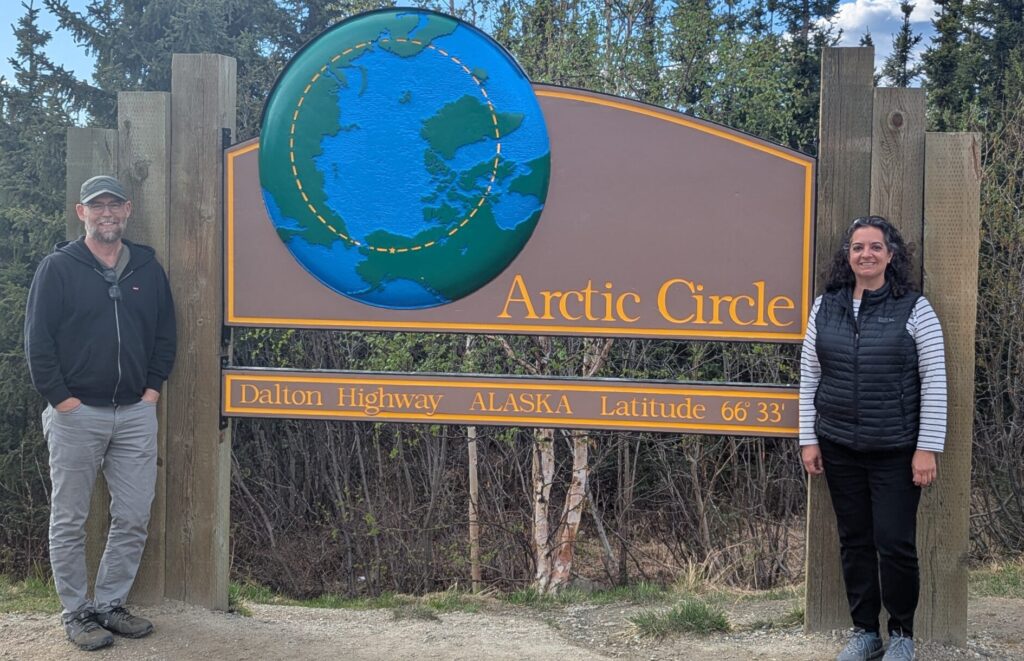Endless Day, Endless Road
The allure of the Arctic Circle – that invisible line encircling the globe where the sun doesn’t set for a full day in summer and doesn’t rise for a full day in winter – has always held a certain mystique. As I was looking at tours out of Fairbanks, the Artic Circle kept coming up. They say only 3% of the visitors to Alaska make it up that far, and I thought, we should be part of that small group. There were several tour companies and after a lot of looking, I ended up booking the Arctic Circle Fly-Drive Southbound tour with the Northern Alaska Tour Company. This unique experience offered a thrilling combination of flightseeing over the vast Alaskan wilderness to Coldfoot and a ground journey south on the Dalton Highway, bringing us face-to-face with the Arctic’s stark and beautiful reality. What I got was an unforgettable, if somewhat grueling, expedition that definitely tested my endurance.

The adventure began with a knot of nerves. Our transportation was a small, 8-passenger plane, and to my surprise (and slight trepidation), Justin and I were assigned the front seats, right behind the pilot. Our pilot was fantastic, though, pointing out sights from above: the winding ribbon of the Yukon River, distant mountain ranges, the impressive Trans-Alaska Pipeline snaking across the landscape right next to the Dalton Highway. The aerial views were truly breathtaking, offering a sense of the immense scale of Alaska.

We landed in Coldfoot, Alaska, a tiny outpost in the vast wilderness. Here, we met our first land guide and headed to Coldfoot Camp for lunch. The cafe is also the most northern saloon in the US. Our pre-selected sandwiches with a bag of chips, fruit, drink, and a cookie were already ready, which was efficient, but we found ourselves with a solid 60-90 minutes of downtime – a bit too long in my opinion, especially knowing the long road ahead. We were shown around the camp, seeing the practical 3-season tents used by staff, the small inn for overnight guests, and the gas pumps, where gas was a whopping $7.50 a gallon! A stark reminder of the cost of remoteness.
After lunch, our next stop was the BLM Arctic Interagency Visitor Center. This new-looking building was a welcome change, filled with interesting exhibits about the Arctic’s ecology, geology, and cultures. Knowledgeable volunteers were on hand to answer questions, and we spent a solid 45-60 minutes here, absorbing the information.

Then, it was time for the “drive” portion of the tour along the legendary Dalton Highway. We would be driving 174 miles on the highway and then a little more to get back to Fairbanks. Without stops this would be about 5 1/2 hours. Our guide, who had lived in Coldfoot for a decade, was a true font of knowledge about the area, its people, and the pipeline. She was driving us the 60 miles to the Artic Circle sign where we would meet up with our second driver. But before we get there, our drive. We saw a moose on the side of the road near a small pond of water, and the guide pulled over for just a few minutes so we can all take a look.

Maybe about halfway through the drive, we pulled over at a view of the pipeline. While we had seen the pipeline a good length of the road already, this stop gave us an up close view (although not be the best view/angle since it was encased in a bridge above a small river) where the guide told us a little bit about why the pipeline came to be, and both sides for and against it. She mentioned the highways role in its construction, the construction materials, length (800 miles) and time it took to complete (three years and two months). Justin mentioned to me one of his uncles worked on the pipeline. (in Fox, just 20 minutes north of Fairbanks, there is a good interpretive sign, example and better up close view of the pipeline that we came across a few days later).
After the 15-20 minute stop, we continued our drive, constantly looking for wildlife out the windows, but there was not a lot of activity. We finally reached the big designation. We made a turn off the road, to where the Arctic Circle sign is. It was a 30-45 minute stop – more than enough time to take few photos, use the toilet, talk, take more photos, and then back into the van. Although this was one of the highlights of the tour, the stop here was also long. This is where a subtle shift occurred: a different driver took the wheel (who had driven another tour up that morning). And because our group was small (only 8 people), we didn’t get the larger, more comfortable van. Also, the guides, perhaps due to the small group, didn’t enforce the usual rotation of seats at each stop, leading to some long stretches in the same spot, and a soreness in my neck for looking left so long.

Soon after the sign, our new guide pulled over and led us a short way down a path into a field. He demonstrated something truly unique: scooping away a thin layer of topsoil to reveal the permafrost beneath. We all had the opportunity to reach down and touch the ancient ice embedded just below the surface – a tangible connection to the frozen heart of the Arctic. The lichen on top acts as a a barrier to help insulate the ice. He said the permafrost could be 700 – 2,000 feet deep into the ground. We let that sink in.

After this fascinating stop, the rest of the drive felt like a marathon. We only had two more stops: dinner at Yukon Camp and a final bathroom break. The road, as expected, was long and bumpy, and with the sun still shining brightly (it was late May, after all, so no real dusk or dawn), the hours stretched on. During the course of the ride we saw somewhere between 35-50 trucks pass us going north on their way towards Deadhorse / Prudhoe Bay. The guide says somedays around 100 trucks might be traveling. Seems like so many going to such a remote area for to transport supplies, equipment, and personnel to support the oil industry activities in this remote region. It made me more curious about what the operation is like up there — I can’t even imagine it’s size and complexity.

We arrived at Yukon Camp for dinner at 10 PM; were were the only group there. We had preordered this optional meal in the morning. Justin selected the hamburger with a side of chili and I ordered the salmon tacos with a size of waffle fries. Most of the dinners came out fast and the folks were almost done with theirs by the time Justin and my dinner came out at 10:40, adding yet more unplanned waiting time to an already lengthy day. The portions were large, too much to eat so late at night. If I knew my dinner would have delayed us 45 minutes, I wouldn’t have ordered it! I’d have rather not eaten or had just a small snack. By this point, I just wanted the day to be over.
We got back on the road about 11:30 and drove another 90 minutes or so to our final bathroom break around 1 AM. The light was just a little dim, but I could hear birds chirping, as if it were 30 minutes before sunrise. It was a bizarre, twilight-like existence. We finally rolled back into Fairbanks around 3 AM, two hours after the estimated return time. When we were dropped off they gave us our certificate for crossing the arctic circle, by that point, I wasn’t excited anymore. We got into bed by 3:30 AM and fell fast asleep.
Would I recommend it? It truly depends on your tolerance levels. If you enjoy many, many hours of bumpy roads, sitting in close quarters with others in a van, then sure, the four or so intermittent stops were genuinely interesting. The tour company and personnel were absolutely fine people. No complaints there.
In hindsight, this excursion was probably the worst idea I’ve had in years. I definitely underestimated how long 174 miles on the Dalton Highway would take, given the slow speeds dictated by road conditions. It tested my patience several times between long stops, the lady taking 3 million photos and hearing her camera click every few seconds, another lady talking and complaining a bunch, being thirsty because they told us to bring water bottles to fill up along with way, but there were only two places to do that, at the start at the BLM visitor center when by bottle was still full, and again at the Yukon River Camp. Since we were only allowed 10 pounds of luggage due to the plane size, carrying more liquids is not really possible when you have layers of clothing, cameras, snacks, a full water bottle, etc. Being 2 1/2 hours later than expected, and them being nice to go out of the way to drop people off even if it made us wait in the van another 45 minutes when we just wanted to be done. I knew I was getting tired and cranky, when was the last time I was up for 20 hours? It taught me a valuable lesson about fully appreciating the logistics of remote tours, especially when endless daylight makes time feel irrelevant.
If I had to do it over again, I would likely opt for a roundtrip flight, skipping the extensive drive and the Arctic Circle sign. Maybe instead going to the northernmost town in the US for a night or two. However, the experience did highlight something incredibly exciting: Coldfoot is directly under the Aurora Oval. This has put the tiny outpost on our radar for a dedicated long weekend winter trip to fly in and out, specifically to experience the Northern Lights, which I imagine would be an entirely different and more magical experience. (and I don’t think I would want to drive that distance on the Dalton Highway in the winter).

